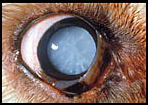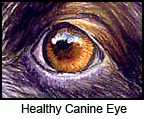|
Canine CataractsCanine cataracts are one of the most common form of eye problems affecting dogs. They can affect all ages and breeds of dogs, but certain types of cataract show up more commonly in certain breeds. Unfortunately Schnauzers, especially Miniatures, may be more likely to suffer from canine cataracts than many other dog breeds. Other susceptible breeds include Spaniels, Poodles, Retrievers, German Shepherds and several types of Terrier. What Are the Symptoms?  The symptoms are fairly straightforward. Cataracts cause the dog's eye to become white or cloudy. Sometimes this is described as the lens having a white or crushed ice appearance. Our image shows a dog with a moderate cataract. Note that it is not unusual for older dogs' eyes to become slightly blue-gray. Called nuclear sclerosis, this usually occurs in dogs over 6 years old and normally doesn't affect their vision, so treatment is not usually necessary. What Causes Canine Cataracts? The normal, transparent lens in the eye focuses beams of light onto the retina at the back of the eye. This enables your dog to see clearly. The word cataract literally means 'to break down.' It is a disruption of the normal arrangement of the lens fibers. In simple terms, a complex biological pump keeps the lens covered in a specific water/protein solution. When this is damaged, extra water is pumped into the lens which in turn damages the lens fibers and causes calcium and sodium to be retained. This interferes with the dog's sight by partially or completely blocking the clarity of the lens, resulting in a reduction of the dog's vision. Canine cataracts may be quite small and not significantly affect the dog's sight. However, if the condition is left untreated and the cataract becomes dense enough, the dog may eventually go blind. Congenital Canine Cataracts These are hereditary and are one of the most common form of cataracts. This type of cataract is also the most common one suffered by Miniature Schnauzers and often affects both eyes. It is also known as C.J.C. or Congenital Juvenile Cataracts. Another cause of cataracts is diabetes mellitus. With diabetes, the cataracts are always in both eyes and grow rapidly. In these cases, treatment of the diabetes can often reduce the cataracts. With hereditary or congenital cataracts, symptoms can appear in puppies as young as 5 weeks old. With Schnauzers this is far less of a problem than it was 20 years ago. Responsible breeders have taken dogs testing positive for congenital cataracts out of their breeding stock. (Of course that is not the case with puppy farms or mills, which is one main reason why the problem, although it has been drastically reduced, still exists.)
Good breeders have their sire's and dam's eyes annually tested by a veterinarian as well as testing all puppies before they leave with the new owners. In the UK, puppies can be tested from 5 weeks of age by a specialist BVA vet. The current cost is £35 per litter for up to 5 puppies, then £5 per additional puppy. For this reason, many UK schnauzer breeders believe that all Schnauzer puppies should be tested and they would welcome compulsory eye testing for Schnauzer puppies before they leave for a new home and are registered with the Kennel Club. This is what the American Miniature Schnauzer Club has to say: The AMSC recommends having breeding stock tested by a Certified Veterinary Ophthalmologist once a year. It also recommends having the pups checked as some eye problems can be seen by a Veterinary Ophthalmologist as early as eight weeks of age. Eye problems cannot be detected by your regular veterinarian until full fruition of the condition. A VO can see the condition before it becomes apparent to the owner and thus maybe before it is bred. The AMSC has sponsored research into some of the more common hereditary eye diseases seen in the breed. What is the Treatment? The only treatment for canine cataracts is surgery (unless the cataracts are caused by another condition like canine diabetes). Despite what you may have heard, laser surgery does not exist for canine cataracts, neither is there any proven medical treatment (other than surgery). The good news is that surgery is almost always (85-90%) successful. The dog has to have a general anesthesia but the operation is often performed on an outpatient basis. The procedure is similar to small incision cataract surgery in people. An artificial lens is often implanted in the dog's eye to replace the cataract lens. Dogs can see without an artificial lens, but the image will not be in focus. You'll have to discuss with the ophthalmologist whether your dog would benefit from an artificial lens. Even better news is that once the cataract is removed, it does not recur. However, before your dog can undergo this elective procedure, he has to be fit and healthy and a suitable candidate for surgery. After surgery, the dog has to wear a protective collar until his eye heals and you have to keep him quiet and calm (not always easy with Schnauzers!) You'll also have to administer eye drops several times a day for a few weeks.
DISCLAIMER: Please note, these articles are intended to give a broad outline of various Schnauzer health issues. If you think you may have a serious Schnauzer health problem, please consult your veterinarian. © Copyright Linda Whitwam 2009. No reproduction permitted. |
AVAILABLE ON AMAZON AS PRINTED BOOK AND KINDLE! The definitive manual for owners of Miniature Schnauzers, Giants and Standard Schnauzers

"The Schnauzer Handbook is brilliant and covers almost all you want to know about the breed," Michele L, Bournemouth
"A thoroughly interesting and entertaining book. There’s hardly anything about schnauzers that isn’t in here - it even made me smile!" J. Garrard, Ormond Beach, Florida





